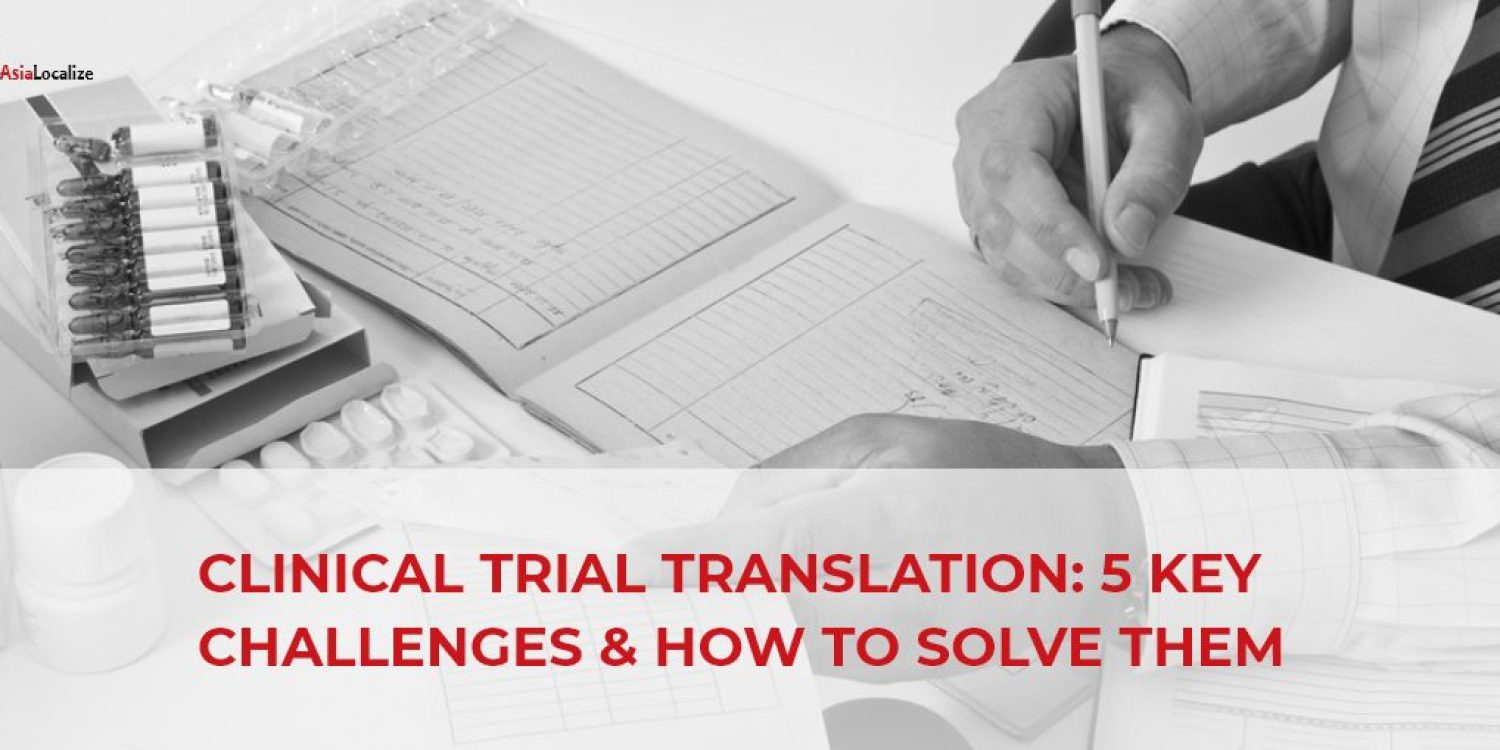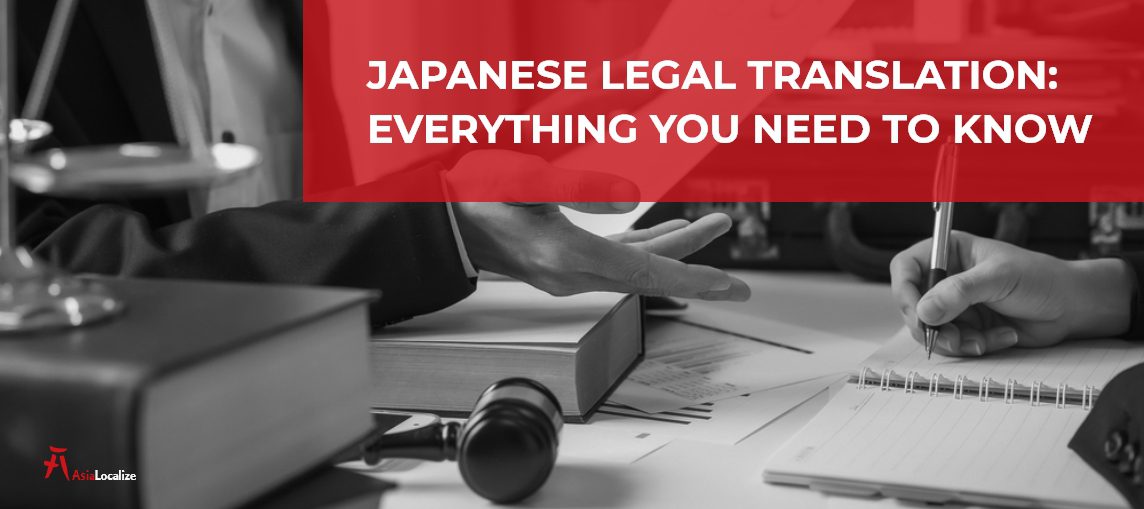Clinical studies are essential for the development of life sciences. Pharmaceutical companies, medical device manufacturers, and clinical research organizations (CROs) from all over the world invest monetary and human resources to obtain results that can bring certainty to years of research while advancing human wellbeing.
Clinical trials take place in a globalized world. And sometimes, the best way to ensure that professionals and communities get the most out of clinical trials is to have them translated into foreign languages.
Since Asia is a major hub for scientific and technological development, language service providers (LSPs) who specialize in Asian languages translation play a key role in facilitating scientific development.
But offering these types of solutions is far from easy. In this post, we’ll take a closer look at the different challenges that a clinical trial translation may entail, through the lens of AsiaLocalize’s strict medical translation process.
Let’s dive in.
Clinical Trial Translation Services: An Overview
Medical translation services involve high-quality standards, commensurate with the critical sensitivity of its content and the requirements of markets, governments, and the scientific community. An accurate translation is key. But in medical translation, quality goes beyond mere accuracy. The highly sensitive nature of medical content, whether personal information or medical data, should be handled with discretion and professionalism. Format compatibility between different cultural and academic spheres is extremely relevant as well. Especially between regions as different as the United States (or Europe) and Asia. In this section, we’ll take a look at how to overcome the 5 most common clinical trial translation challenges:
- Regulatory Framework
- Clarity and Relevance
- Technical Accuracy
- Confidentiality
- Format

1. Regulatory framework
Each state has its own regulatory framework around the life sciences and medical industry, especially the development of drugs and medical devices, from conception to clinical research and trials. In fact, clinical research in particular is a heavily regulated area. These frameworks are in place to verify compliance with standard procedures and protocol requirements. The complexity of these international legal particularities should be carefully navigated for your target country. For instance, the European Union has Regulation EU No 536/2014, a law that establishes a series of principles for ethical and reliable clinical trials. Even foreign organizations have to follow for a clinical trial to be considered valid within the EU.A small problem with the legal fundamentals of your study may prevent it from being seen as valid in a certain region, and your investment would be at high risk. Also, it would give you and your team an evitable, unnecessary amount of stress. Now, imagine the struggle with the different language versions of your clinical trials. Clinical trial translation requirements go beyond mere words and cover several aspects, from communication with volunteers, licenses, sensitive information management, privacy, and more. That’s why it is not easy to launch a clinical trial without a thorough expert review that warns of the potential translation pitfalls that may hold the approval and progress of your clinical trials in a specific region.
How the Right Clinical Trial Translation Company Solves This Issue
The right LSP will take into account the legal framework of the target country, and adapt your material accordingly. Your language partner of choice should be experienced in the legal aspects of clinical trial translation and aware of the nuances of the regulatory requirements between the countries that make up the different regions of Asia. Remember that the diversity of Asian laws can be very wide, but the right company will be an ally to overcome those barriers.
2. Clarity and Relevance
If you’re conducting a clinical trial with foreign subjects, this section is for you. A clinical study is not only communicated among scientists, but also to patients. They are the focus of the research, so they must be able to understand the planned procedure and implications in order to make an informed decision on whether to agree to participate or not in the clinical trials.
This means that your clinical trial translation should offer impeccable levels of faithful and complete rendering of the original text to ensure clarity to make it easy to understand for the target audience. Moreover, considering the cultural aspects of language is crucial for a beneficial, dynamic synergy among scientists and volunteers during your clinical trial. For example, translating patient questionnaires involves keeping in mind the conventions and idiosyncrasies of your target culture. What may be polite to you could be incredibly rude to your patient. Remember: translating clinical trials (and the tools that facilitate them) is not just a matter of technical expertise, cultural understanding is key.
The Right LSP Combines Language Mastery and Cultural Competence
When it comes to translation, native language proficiency is vital. But when it comes to clinical trial translation, native language proficiency is imperative. And it’s why working with a translation agency that relies solely on native-speaking translators, who have an unrivaled language proficiency coupled with translation competence and subject-matter expertise, is the ideal scenario for a clinical research translation.
Additionally, sometimes the difference between the polite and impolite, natural and unnatural, or intuitive and counter-intuitive is very blurred and can turn a bridge into a cliff. There is no one better than an experienced translator who resides in the target country to serve as a local guide to the cultural territory you want to access. Go for a language service provider with native language medical translators. They will help you build the linguistic accuracy and cultural relevance your study needs to be accepted among volunteers and the scientific community.
3. Technical Accuracy
When language and science meet, language becomes a powerful tool that can either make or break your clinical trials. It can either push forward or hinder your progress. Medical language in particular, although seemingly direct and straightforward, is heavily loaded with complex terminology across a wide variety of medical specialities. Mistakes, inaccuracies, and even minor inconsistencies in terminology may be critical for your project. Due to your target country’s regulatory organizations’ requirements and the scientific community tradition and particularities, you need the highest level of accuracy possible.
Go for an LSP with a Large & Dedicated Team
The best clinical trial translation companies are powered by a combination of human expertise and strategic automation. From this union emerges a very fluid dynamic, which will achieve an optimal result in a short time.
With the right LSP, your project is handled by a large team of subject matter experts who are:
.Life sciences translation experts
.Native linguists
.Translators with a medical background and hands-on experience
Additionally, best-in-class medical translation companies leverage cutting-edge translation technology, including CAT tools, translation memories, glossaries, automatic quality assurance tools, and more to:
.Accelerate your project’s turnaround time
.Guarantee terminological consistency
.Lower your costs without compromising quality
You won’t have to worry about misunderstandings, unclear wording, or mistakes, due to the constant review processes and strict quality control that characterizes industry leaders.
4. Security
Security is a key issue throughout the clinical research process. Faced with this problem, researchers have to deal with crucial issues such as ownership of findings, confidentiality, and protection of sensitive data. A leak can have very serious consequences for all trial participants: study directors, investigators, and volunteers. Beyond the legal consequences, it can also be a problem at the operational level (e.g., temporarily or permanently interrupting the research process), or when presenting the results of a long period of work.Moreover, plagiarism is a reality and you should not expose your trial to it. Confidentiality then is a necessary safeguard against any possible leakage and provides transparency about the protection of your documents. But how can you make sure your documentation is safe in the hands of a third-party, such as an LSP?
Best-in-Class Translation Companies Guarantee Confidentiality
Great LSPs have professionalism and experience at their core, which comes with years of efficient and discreet work. Confidentiality agreements make sure that translators will not disclose your sensitive data.Additionally, your medical translation service provider should rely on:
.GDPR-compliant infrastructure
.Internal best practices that prevent human error
.Reputable cloud-based services
These are three important elements to inquire about when contacting potential language partners.
5. Format
It probably seems minor, really underrated, but proper document formatting is crucial in a virtuous scientific process. Readability has many aspects, and format is one of the most important ones. Translating clinical trial documents from one language to another, especially between two languages that may have strikingly different writing systems and set of characters, such as Chinese and Arabic, or English and Korean, has particular implications on the format and accordingly requires layout and design-intensive work, usually referred to as Desktop Publishing.
Apart from text, your clinical trials may include tables, numbers, and figures. If not appropriately formatted, your translated clinical trials documents may end up disorganized, making it difficult to read. Not only that, but this sets your clinical trials for failure to make the intended impact on the participants and the scientific community.
A poorly formatted translation can cost you precious time and come with a high price tag. Your Medical Translation Company of Choice Should Offer Desktop Publishing ServicesThey’ll adapt your documents so they meet the conventions of your target language and region. The best language services providers rely on digital tools that allow them to adjust your documents to best fit the translated text while preserving the original documents’ format. Additionally, they navigate multiple formatting challenges that include text expansion and contraction, font and line spacing, bullets and numbering, line and page numbers, and more.
With the right toolkit, your language partner can ensure your translated documents are equally professional-looking, clear, easy-to-read, and impactful as your original documents
Key Takeaways
Clinical trial translation services involve challenges that, if left unresolved, can critically affect current and future operations in the target country. Clinical trials are processes with very high stakes, which require a high investment of monetary and human resources. So it’s essential to find the right language partner, who can treat your project with the confidentiality and rigor it deserves.At AsiaLocalize we follow strict standards to make your clinical trial documents go beyond language barriers. As a technology-driven translation company, we know exactly how to conduct your project under the rigor, strict confidentiality, cross-cultural sensibility, and speed that today’s scientific landscape requires.Leave nothing to chance: get a free quote or contact us today and put your clinical trial translation in the hands of experts.











